When handling lye for traditional soap making, always wear protective gear: rubber gloves, safety goggles, long sleeves, and closed-toe shoes. Work in a well-ventilated area away from food preparation spaces. Pour lye slowly into cold water (never water into lye) and stir gently. Store in airtight HDPE containers with clear warning labels. Keep vinegar nearby for neutralizing spills. These essential safety practices transform a caustic chemical into the cornerstone of your homestead soap crafting.
Essential Safety Gear for Homestead Soap Making
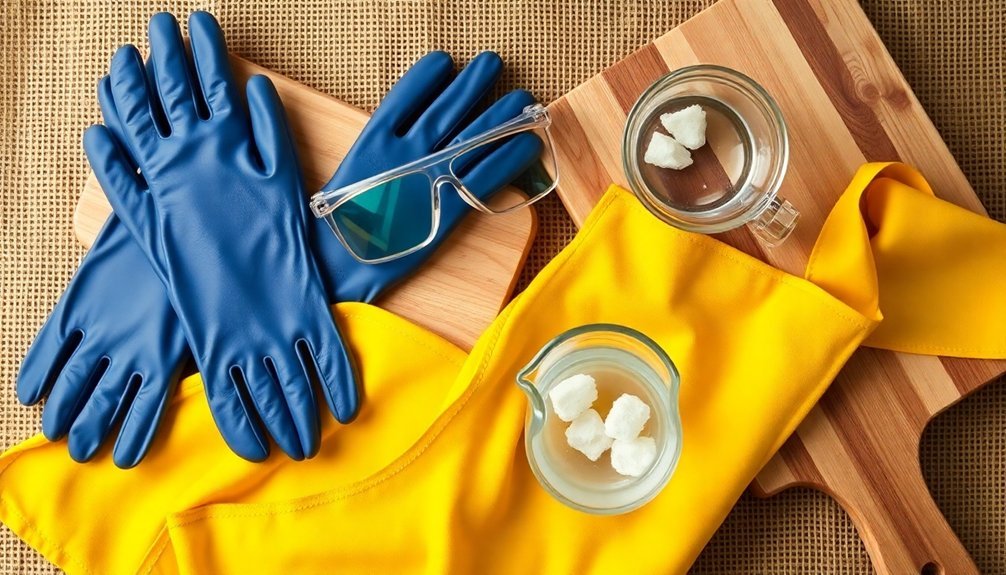
When working with lye, proper protection isn't optional—it's essential. Cover your body with long sleeves, pants, and closed-toe shoes to shield your skin from potential splashes.
Always wear rubber or nitrile gloves that extend up your wrists, and consider long kitchen gloves for better coverage.
Protect your eyes with safety goggles—even over prescription glasses—and use a dust mask or respirator if you're working in an area with limited airflow.
An apron provides an extra barrier against spills, while hair ties keep loose strands from falling into your soap mixture.
Remember that lye can cause severe chemical burns as it's highly corrosive and requires dedicated equipment for safe handling.
Never compromise on these protective measures. The few minutes it takes to gear up properly can prevent serious chemical burns and other injuries that might otherwise turn your soap-making experience into a painful lesson.
Creating a Dedicated Lye Workspace
You'll need a dedicated area with proper ventilation to safely handle lye, ideally with windows or exhaust fans to direct fumes away from your breathing zone.
Prepare your workspace by covering surfaces with protective materials like polypropylene cutting boards or stainless steel trays that resist lye's corrosive properties.
Be sure to clear all clutter and keep your lye workspace separate from food preparation areas to prevent contamination. Always wear recommended personal protective equipment including eye protection, lye-resistant gloves, clothes that cover skin, and closed-toe shoes for maximum safety.
Ventilation Is Crucial
Proper ventilation stands as the cornerstone of safe lye handling due to its caustic nature and potential to release harmful fumes.
Always work in a well-ventilated area to prevent respiratory damage from lye vapors.
Install local exhaust ventilation systems that capture fumes at their source, positioning hoods directly above your lye mixing station.
Don't rely solely on general ventilation—it's rarely sufficient for hazardous chemicals like sodium hydroxide.
Ascertain your system includes proper make-up air inlets to maintain airflow balance.
Regularly check your ventilation equipment for effectiveness and conduct routine air quality monitoring.
If natural ventilation is your only option, work near open windows with fans directing air outward.
For homestead workspaces handling lye, consider installing filtration systems with MERV 13 filters to remove fine particles that could carry lye residue.
Protective Surface Preparation
Beyond ventilation, a thoughtfully prepared workspace forms the foundation of safe lye handling.
You'll need a dedicated area that's clean, organized, and secured against unauthorized access. Remove all clutter and food items from countertops to prevent contamination and create space for your equipment. Maintaining a clutter-free workspace is critical as lye can cause severe chemical burns upon exposure.
- Cover your work surface with multiple layers of newspaper or a thick plastic sheet that can catch spills and be easily disposed of after use.
- Position your heat-resistant mixing container on this protective surface, with all tools arranged neatly within arm's reach.
- Place a bottle of vinegar nearby as a neutralizing agent for any accidental lye spills, along with your clearly labeled supplies and safety equipment.
Always clean thoroughly after each soap-making session, using vinegar to neutralize any lye residue.
The Science Behind Lye Reactions
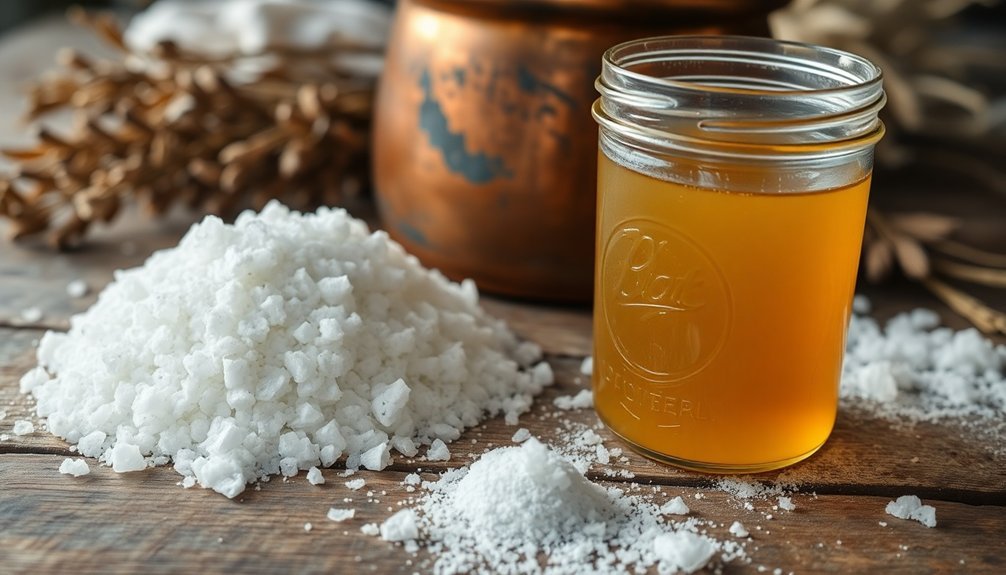
Understanding the chemistry behind lye reactions illuminates why this powerful compound demands such careful handling. When sodium hydroxide (lye) meets acids, it forms water and salts through neutralization—for example, combining with hydrochloric acid creates sodium chloride and water.
In soap making, lye's most celebrated application is saponification. This exothermic reaction transforms triglycerides from fats and oils into soap and glycerin, requiring precisely three lye molecules per triglyceride.
Lye also reacts dramatically with metals. When it encounters aluminum, it produces sodium aluminate and hydrogen gas. With dissolved copper or zinc, it creates distinctive colored precipitates (light blue for copper, white for zinc).
These reactions explain why you'll need non-reactive equipment and why protective gear isn't optional—it's essential. When dissolved in water, lye dissociates into sodium and hydroxide ions, making the solution highly alkaline and potentially harmful to skin.
Step-by-Step Mixing Procedures
You'll need to measure your lye with digital precision, as even small variations can affect your soap's quality.
Always pour your lye crystals into cold water—never the reverse—to prevent dangerous splashing and excessive heat buildup.
Add the lye gradually while stirring gently in a consistent direction to guarantee proper dissolution and minimize the risk of caustic clumps forming.
The lye solution will naturally heat up significantly when mixed, so place it in a safe location away from children and pets while it cools to the appropriate temperature.
Precise Measuring Matters
When working with lye, precision isn't just about following recipes—it's a critical safety requirement.
Using a digital scale with tare functionality guarantees you're adding exactly what your formula demands—never eyeball measurements or use volume-based tools like measuring cups for lye.
Always measure in this sequence:
- Place your heat-resistant glass or stainless steel container on the scale, press tare to zero it out, then carefully weigh your water first.
- After measuring water, move to a well-ventilated area, wear your protective gear, and precisely weigh your lye in a separate container.
- Slowly add the lye to water (never water to lye!), stirring gently with a non-reactive utensil to prevent clumping and dangerous splashing.
Remember that solutions with pH above 9 can cause skin irritation during extended contact, making proper measurement and handling essential for both effective results and personal safety.
Cold Water First
Three critical steps define proper lye handling, with using cold water as your foundation.
Always add lye to cold water—never the reverse—to prevent dangerous eruptions and excessive heat. This exothermic reaction demands respect and proper ventilation.
Use stainless steel or heat-resistant plastic containers for mixing, avoiding aluminum which reacts with lye.
Wear protective gear including rubber gloves and safety goggles throughout the process.
Stir gradually and thoroughly as you add lye to water, preventing undissolved crystals that could cause caustic spots in your final soap.
Allow the mixture to cool to approximately 100°F before proceeding with soap-making.
After mixing, label your solution clearly and store it safely away from children and pets.
Clean all equipment promptly and thoroughly to prevent contamination or accidental exposure.
The reaction between lye and oils creates sodium salt compounds that become the cleansing agent in your finished soap.
Gradual Addition Technique
The gradual addition technique represents the heart of safe lye handling. When you're ready to mix, sprinkle small amounts of lye into your water slowly while continuously stirring. This methodical approach prevents dangerous clumping and reduces splashing risk.
You'll notice the water heating up rapidly as the lye dissolves—this exothermic reaction can reach temperatures over 200°F, so patience is essential.
- Add lye in tablespoon-sized increments, stirring thoroughly between additions until the granules fully dissolve.
- Position yourself at arm's length while adding lye, keeping your face turned slightly away to avoid any rising fumes.
- Maintain a gentle stirring motion with your stainless steel spoon, creating a subtle vortex that helps distribute the lye evenly without splashing.
When using traditional wood ash lye, remember that multiple filtration steps may be necessary to achieve the proper strength for effective soapmaking.
Emergency Response for Lye Accidents
Despite preventive measures, lye accidents can occur and require immediate, decisive action.
If someone suffers a lye burn, flush the area with cool running water for at least 15 minutes, then remove contaminated clothing while continuing to rinse. Never apply neutralizing agents to burns.
For inhalation, move the victim to fresh air immediately and seek medical attention.
If lye is ingested, don't induce vomiting—offer water if the person is conscious and call Poison Control. An important consideration is that as little as 1.57 mg/kg can constitute a lethal oral dose of lye.
When handling spills, evacuate untrained personnel, don protective gear, and contain the spill with dry materials like sand.
Avoid water initially, as it can cause splashing.
Guarantee proper ventilation during cleanup and document the incident for future safety improvements.
Proper Storage Solutions for Soap Making Materials
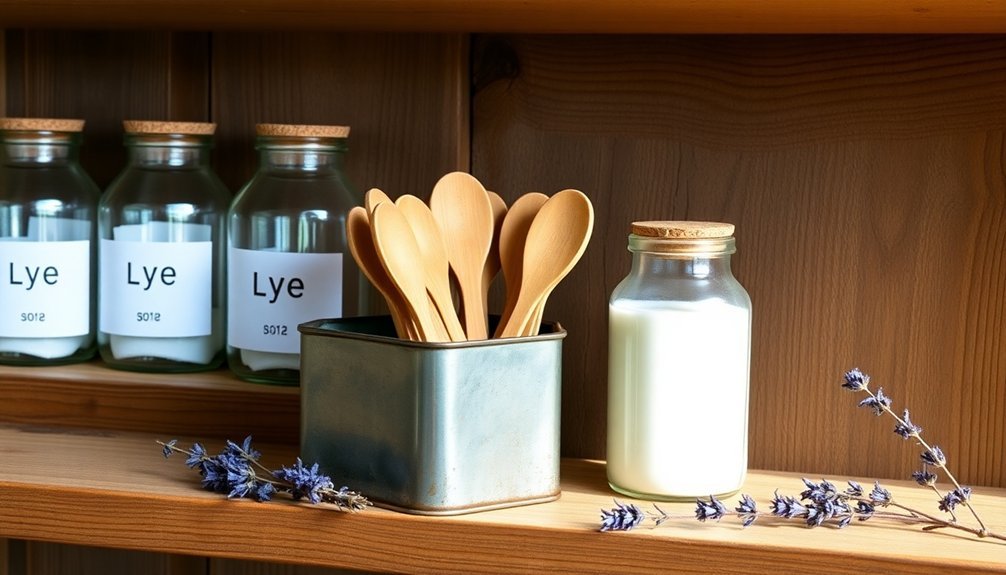
Proper storage of soap making materials guarantees both safety and product quality throughout your crafting process.
Store lye in airtight HDPE or PP containers with clear labeling, away from children, pets, and heat sources.
For finished soaps, choose cool, dry environments with good air circulation—consider using shrink wrap bands rather than sealed containers to maintain proper airflow. Cold process soaps need to cure for 4-6 weeks to develop hardness and longevity.
Your melt and pour soaps require special attention—wrap them immediately and store in dry locations to prevent the "sweating" that occurs in humid conditions.
- Vertical shelving systems with labeled, color-coded containers transform chaotic workspaces into efficient production zones
- Dedicated zone layout with separate areas for mixing, curing, and packaging streamlines your workflow
- Humidity-controlled storage area with dehumidifiers protects your finished products from moisture damage
Traditional Recipes and Measurements
Mastering traditional soap recipes requires precise measurement and careful attention to ingredients, especially when working with lye.
You'll need a digital scale to weigh—never measure by volume—all components for safety and successful saponification.
When crafting traditional soaps, calculate your lye amounts using a dedicated calculator based on your chosen oils. Coconut, olive, and lard oils each require different lye ratios.
Always add lye to water (never reverse), aiming for concentrations between 20% for hard bars and 10% for liquid soaps. Working in a well-ventilated area helps prevent inhalation of potentially harmful lye fumes during the mixing process.
Both cold process (room temperature mixing) and hot process (heated) methods require proper temperature control—keep your lye solution and oils between 100-120 degrees for best results.
Don't forget to include a 5-8% superfat calculation to guarantee your finished soap won't irritate skin.
Tools of the Trade: Equipment Selection
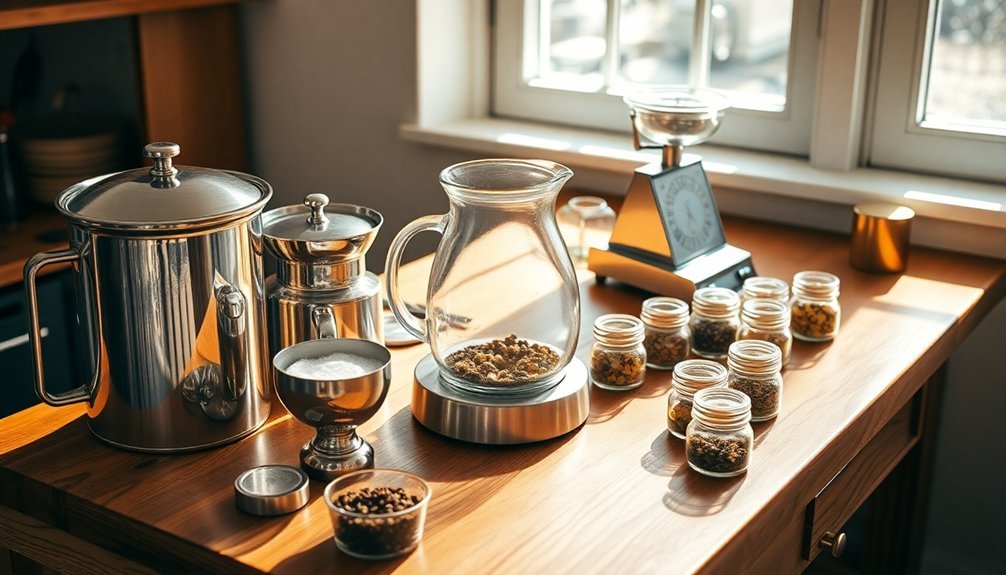
Working safely with lye demands specialized equipment that protects both you and your soap-making process. Your toolkit needs to include protective gear like rubber gloves that cover your elbows, safety goggles, and a face mask to shield you from potential splashes and fumes.
Always work in a well-ventilated area to reduce inhalation risks.
For precise soap crafting, you'll need:
- Stainless steel containers and tools that won't react with lye – plastic can melt and aluminum creates dangerous reactions
- An accurate digital scale for measuring ingredients down to the gram – eyeballing measurements can result in caustic soap
- A reliable thermometer to monitor temperatures throughout the process – ensuring proper saponification without dangerous overheating
Proper organization of your workspace ensures easy access to all necessary tools, creating a safer and more efficient soap-making environment with comprehensive tools range.
From Dangerous Chemical to Gentle Soap: The Transformation Process
The seemingly miraculous transformation from caustic lye to gentle soap unfolds through saponification, a chemical reaction that completely changes the molecular structure of your ingredients.
When sodium hydroxide meets oils, they react to form soap and glycerin. One triglyceride molecule combines with three NaOH molecules, creating three soap molecules and releasing glycerin.
This transformation isn't just chemical—it's also practical. The caustic lye disappears entirely, leaving you with a mild cleansing product. The superfats enhance softness of your finished soap, making it gentler on the skin. The glycerin naturally produced during this process acts as a humectant, helping your skin retain moisture.
You'll notice this change as your soap cures over several weeks. During this time, excess water evaporates, the soap hardens, and any remaining alkali neutralizes, resulting in a perfectly balanced bar for your skin.
Teaching Others: Passing Down Safe Soap Making Traditions
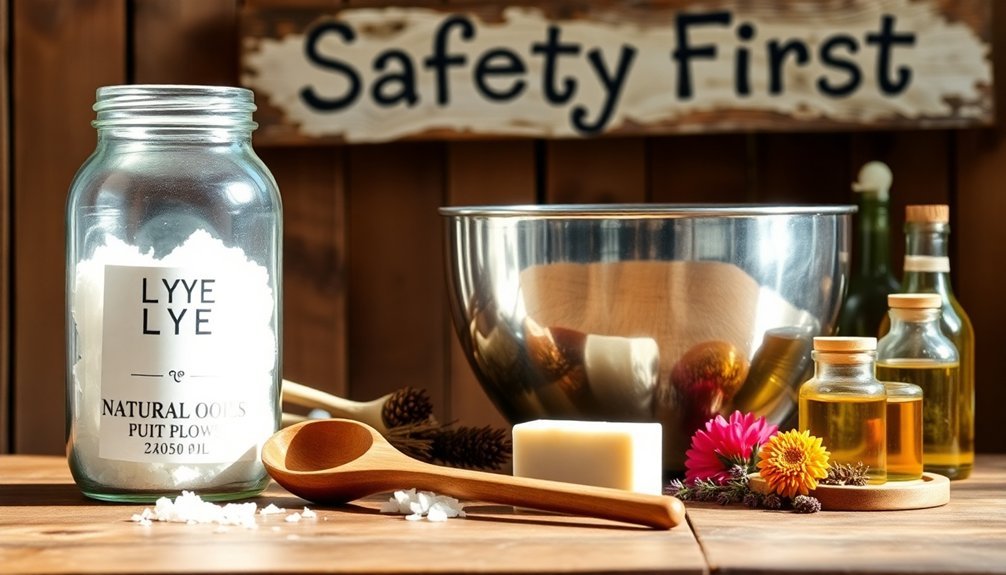
When you're teaching family members the art of soap making, emphasize lye safety first before covering more creative aspects.
Community workshops offer a perfect setting to demonstrate proper protective equipment and ventilation while building connections with fellow crafters.
Your written instructions should include clear warnings, specific measurements, and step-by-step safety protocols that new soap makers can reference repeatedly.
Remind participants that colonial women considered soap making one of the most difficult jobs on the homestead due to the caustic nature of lye and the lengthy boiling process required.
Family Soap-Making Lessons
Family traditions centered around soap making provide wonderful opportunities to pass down valuable skills while creating lasting memories with loved ones.
When teaching soap making to family members, start with melt-and-pour techniques for beginners before advancing to more complex methods. Always emphasize safety first—proper gear, ventilation, and careful handling of lye are non-negotiable lessons. Cold process soap making requires special attention when maintaining a disturbance-free area to ensure consistent results and safety for all participants.
Create a structured learning environment with:
- Dedicated stations where each person has clearly labeled materials and safety equipment
- Visual demonstrations showing proper techniques before participants try themselves
- Family recipe books where everyone can document their creations and modifications
Community Workshop Safety
Organizing community soap-making workshops requires meticulous attention to safety protocols, especially when teaching lye handling to others.
Begin by distributing detailed written materials that outline proper protective gear and emergency procedures before any hands-on activities.
Set up your teaching space with proper ventilation, lye-resistant surfaces, and clear boundaries to prevent unauthorized access.
Always demonstrate the correct method of adding lye to water while explaining the science behind this vital step.
Encourage beginners to start with small batches under close supervision, and incorporate visual checklists to guarantee everyone follows safety procedures.
For proper protection during workshops like the one at Ijams Nature Center, instructors should remind participants to wear closed-toe shoes and long sleeves as required safety attire.
Create opportunities for questions and feedback to reinforce learning.
Establish a mentorship program where experienced soap makers guide newcomers, creating a community that values both tradition and safety in equal measure.
Written Instructions Matter
Passing down soap-making traditions requires meticulous written documentation, especially when teaching others about lye's dangers. Your written instructions serve as both safety protocol and family legacy, ensuring knowledge transfers accurately between generations.
When creating your soap-making documentation:
- Label all containers clearly with "POISON" or "CAUSTIC – DO NOT TOUCH" warnings, using bold red lettering that's visible from across the room.
- Develop a step-by-step checklist that emphasizes adding lye to water (never reverse), complete with temperature targets and ventilation requirements.
- Create a troubleshooting guide documenting common mistakes and their solutions, including emergency procedures for lye contact with skin or eyes.
Include safety gear requirements specifying that proper protection with rubber gloves must always be worn when handling lye to prevent chemical burns.
Run all recipes through a lye calculator before sharing them, as traditional measurements may need modern adjustment for safety.
Frequently Asked Questions
Can I Use Lye for Cleaning Drain Pipes?
Yes, you can use lye for cleaning drain pipes. It effectively dissolves organic clogs like grease and hair. Always wear protective gear, guarantee good ventilation, and follow safety precautions as lye is highly caustic.
How Long Should Lye Soap Cure Before Use?
You'll need to cure your lye soap for 4-6 weeks before using it. This guarantees complete saponification, reduces skin irritation risks, and improves soap qualities like hardness, durability, and lather.
Can I Substitute Lye With Natural Alternatives?
You can't truly substitute lye in soapmaking with natural alternatives. While saponin plants offer cleaning properties, they don't make real soap. For lye-free options, try melt-and-pour bases that already contain processed lye.
How Does Altitude Affect Lye Solution Measurements?
Altitude doesn't affect your lye solution measurements. You'll still use the same weight ratios of lye to water regardless of elevation. The reaction might proceed slightly slower, but you don't need to adjust your concentration calculations.
Is Lye-Processed Food Safe for Consumption?
Yes, lye-processed food is safe for consumption. You're eating harmless compounds, not actual lye, as it completely neutralizes during cooking. The FDA regulates food-grade lye to guarantee all products meet safety standards.
In Summary
You've now mastered the essential skills for safely working with lye on your homestead. Remember, respect this powerful ingredient, not fear it. Always wear your protective gear, follow proper mixing procedures, and keep emergency supplies nearby. With practice, you'll transform this caustic substance into beautiful, gentle soap that connects you to generations of traditional crafters. Share your knowledge wisely—you're preserving an authentic homesteading art.

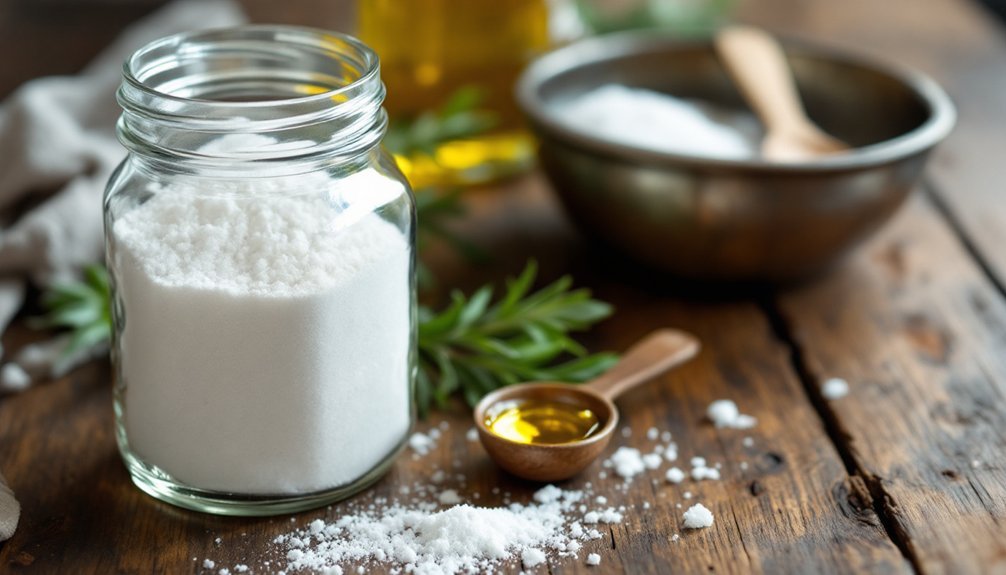



Leave a Reply